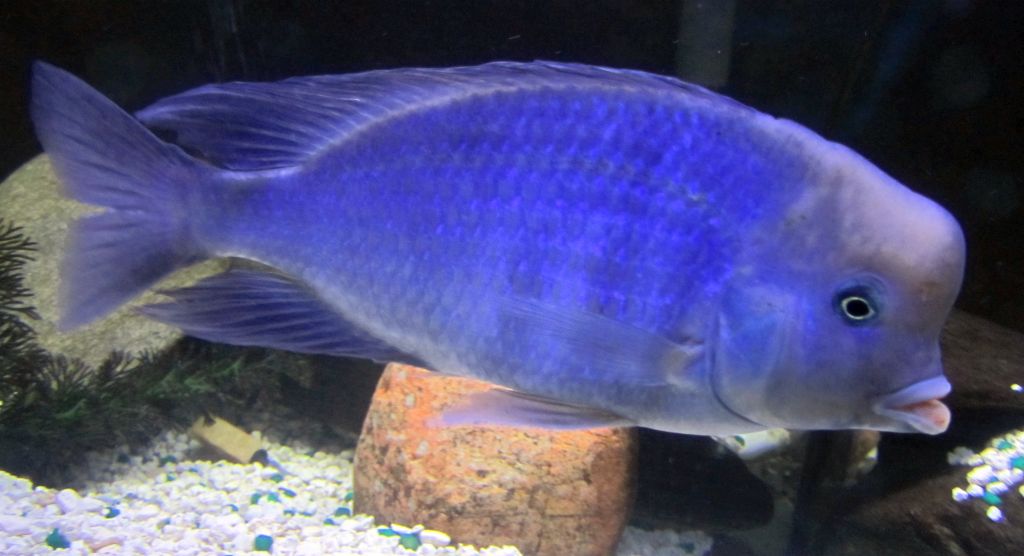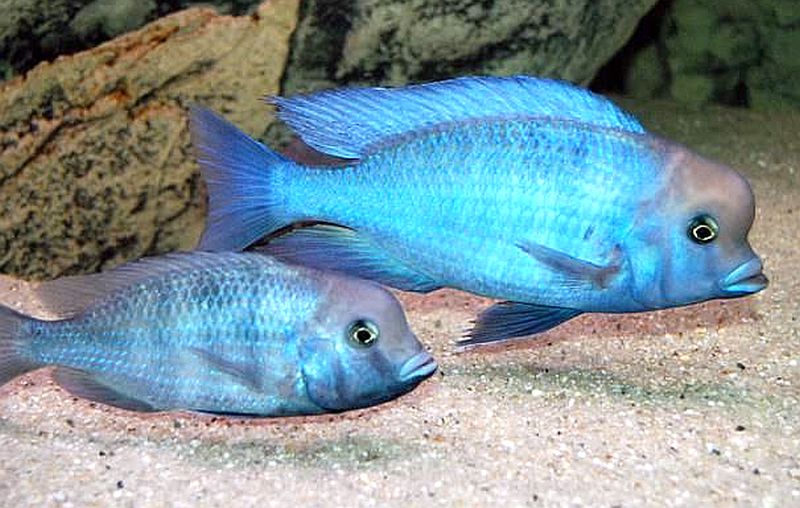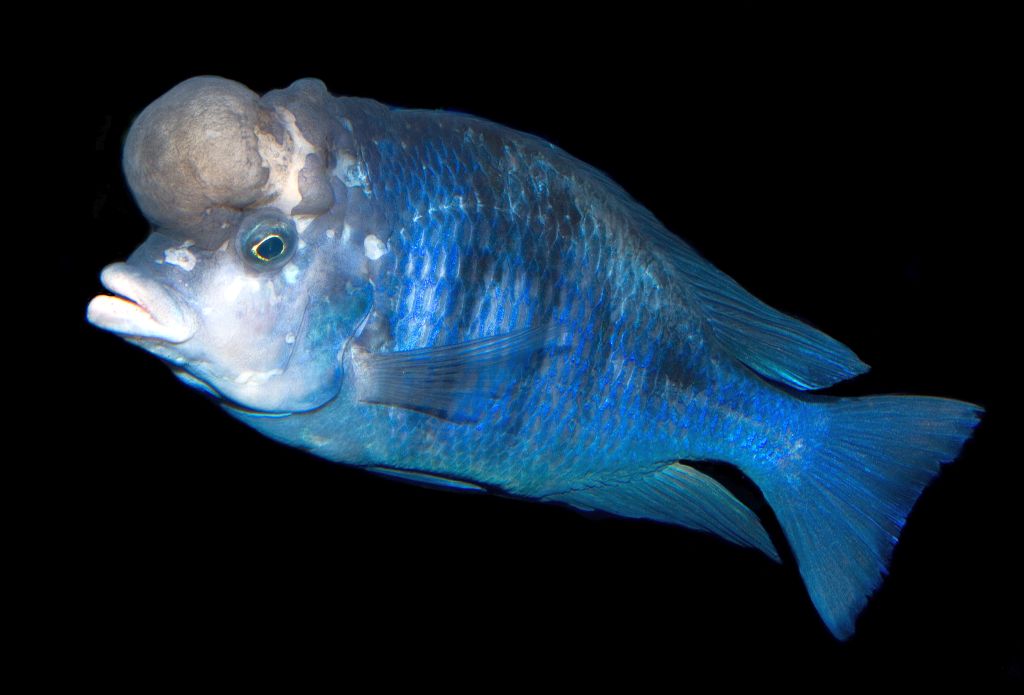The Blue Moorii Cichlid (Cyrtocara moorii) is also referred to by tropical fish keeping enthusiasts as the Blue Dolphin Cichlid, Malawi Blue Dolphin Cichlid, Hump head, Blue Lumphead, Hap moorii, and Humphead Mouthbrooder.
The Blue Moorii (Cyrtocara moorii); previously listed as Haplochromis moorii, is a rather large exotic species that comes from Lake Malawi in Africa. They frequent the sandy coastal areas throughout the lake and reside at depths between 10 to 50 feet. They are a shoaling species that feed on small benthic invertebrates which are often rooted out of the sandy substrate by Fossorochromis rostratus, some species of Taeniolethrinops, and other sand sifting Haplochromine cichlids.
The overall coloring of the Blue Moorii is a beautiful blue with varying amounts of black markings that are dependent on where each individual comes from. They have compact, somewhat elongated bodies with elongated snouts. Both males and females develop a large cranial bump on their heads as they age, which makes them excellent show specimens for a larger aquariums and lends to their “hump head” alias. Their cute pointed snout situated just below their cranial hump also lends to their Dolphin like appearance.
Their Hump head name is often confused with the Frontosa Cichlid (Cyphotilapia frontosa) which is found in Lake Tanganyiika however this fish is easily identified by its six or seven broad black stripes over their white body.
The Blue Moorii is a polygamous, relatively peaceful species that can be quite aggressive with males of their own kind. The should be kept with one male in a tank with three or more females. They become highly territorial during spawning but unlike other cichlids, do not maintain their territory after spawning is completed.
Blue Mooriis are often called the “gentle giant” of the cichlid world. They can be kept in an all cichlid community tank with some of the more mildly tempered Malawi species, with Peacock cichlids of the Aulonacara genus, Frontosa, and with some of the larger haps of the same general size. In a single species tank, it is best to keep a single male with three or more females.
Blue Moorii can be also be kept with larger Synodontis Catfish but should never be included with any of the Mbuna species of Lake Malawi.
Crytocara moorii need a large long tank of at least 75 – 100 gallons, a sandy aggregate of argonite or crushed coral, plenty of rocks, caves and passageways to hide among, clean moderate water movement, and plenty of free swimming space. They require regular weekly water changes of 10 to 20% to keep them disease free. All Malawi cichlids will deteriorate if they are not kept in clean, hard, alkaline water conditions however, poor water quality will quickly ruin the eyes of Blue Moorii.
The Blue Moorii cichlid is not easy to breed in an aquarium environment, which is why most specimens found in tropical fish
shops are collected in the wild. Because they are difficult to sex, the best way to develop a breeding group is to house 8 to 12 juveniles in a tank and let them grow up together.
The reach sexual maturity when they are about 5 inches in length. Males will pick a breeding site and either dig a pit for the eggs or clean off a flat stone or piece of slate. When the site is considered ready by the male, he will display intense breeding colors to invite a willing female. When ready, a female will approach the site, lay her eggs, and the male will then fertilize them.
Crytocara moori are specialized mouth brooders and the fertilized eggs will be picked up by the female into her mouth for incubation. After the eggs have hatched, the female will continue to hold anywhere from 20 to 90 fry in her mouth until they are able to fend for themselves. The fry are usually released within 12 to 20 days when they are about 1/4″ long. On her own the female will not eat the fry but will hold them in her mouth at night or if she feels they are in danger; however once released, the fry will usually no longer return to the female.
Feed the fry baby brine shrimp and finely crushed carnivore flakes until they are able to eat adult foods. They are slow growers that should be given a high protein diet.
Adult Blue Moorii do best on a high protein diet of live, frozen or freeze dried bloodworms, tubifex
, brine shrimp
, small pieces of chopped earthworms, fish or prawn, and a supplement of high quality carnivore pellets. They do best when fed several small portions daily instead of only once a day. Some tropical fish keeping enthusiasts feed their Blue Moorii chopped beef heart, however, meat from warm blooded animals has been known to cause serious digestive ailments in these fish.
When available for purchase, Blue Moorii are usually sold as juveniles at only 1″ to 1 1/2″ in size.
Minimum Tank Size: 75 gallons
Care Level: Moderately difficult
Temperament: Semi aggressive
Aquarium Hardiness: Moderately hardy
Water Conditions: 73.0 to 82.0° F, dGH 10 – 18°N, pH 7.2-8.8
Max. Size: 10 ”
Color Form: Blue, Black
Diet: Carnivore
Compatibility: Best kept in groups of 1 male with 3 or more females.
Origin: Lake Malawi, Africa
Family: Cichlidae
Lifespan: 10 years
Aquarist Experience Level: Intermediate to Experienced




